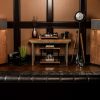Hack #25 from Home Theater Hacks by Brett McLaughlin (O’Reilly Media).
Running your components and cables for some arbitrary length of time when they are first purchased isn’t helpful, but letting them power on and sit for a few minutes before watching movies or performing calibration is.
With even simple home theater systems now needing universal remotes [Hack #84] and calibration to perform well, a lot of well-meaning folks have passed around some home theater myths, or at best, misunderstandings. One of these is that you need to burn-in your equipment. Burn-in is a term used to refer to running your gear for some arbitrary length of time, usually several hours, to help it perform properly. You’ll most commonly hear about burnin when talking about speakers, which often can benefit from this sort of treatment.
Warm Your Components Up, Don’t Burn Them In
Some well-intentioned folks have taken this idea and applied it to audio and video cables (discussed next), as well as audio components. In the case of cables, this is just an outright misunderstanding of electronics; in the case of components, it’s more likely a misunderstanding; a confusion between burn-in and warm-up. Warming up a component is just what it sounds like — turning on a piece of equipment and letting it run for a while. Electronics need warm-up time, not burn-in time. Most modern electronics warm up in 1 to 5 minutes. In this time picture tubes and lamps begin to operate consistently, transistors perform as they should, and your system generally settles (metaphorically speaking).
Really heavy-power amplifiers might need 10-20 minutes to reach their steady-state temperature.
Giving components a few minutes to get to this optimal state will result in a better home theater experience, allowing your system to perform at its best.
Cable Burn-In Is a Waste of Time
You’ll also often hear that you should burn-in your speaker cables, as well as your components. These burn-in periods have as little effect on your home theater as the length of your speaker cables (see Chapter 5).
Cables don’t have some sort of “memory” that is altered in the first few hours of use. This is a slight misunderstanding of electrical fields involved. Yes, electromagnetic fields do have an effect on the dielectric, the white foam that surrounds the center wire of your interconnect cables. As the audio or video signal sweeps up and down (all “within” the cable), the effects of the first half of the signal are reversed by the second half. If you have an electronics background you know that the electromagnetic field depends on current moving through a wire, and it’s this current that turns out to be the overriding factor in how a cable behaves over time. With interconnects, very little current is flowing through these cables, so burn-in is essentially a waste of your time.
The one way that a signal can alter the cable is if the signal has enough current with it to heat the cable, and to melt the cable’s crystalline structure. This type of burn-in is prone to bring the fire department running rather than your local home theater enthusiasts.
— Robert McElfresh

This material has been adapted from Home Theater Hacks by Brett McLaughlin, published by O’Reilly Media, Inc. Copyright O’Reilly Media, Inc., 2005. All rights reserved.
A smart collection of insider tips and tricks, Home Theater Hacks covers home theater installation from start to finish, purchase to experience. Just imagine: no frustrating trial and error process and better yet, no expensive appointments with installation experts. Home Theater Hacks prevents both by imparting down-and-dirty technique not found anywhere else.
Home Theater Hacks is available for purchase from Amazon.com, Amazon.co.uk, and Amazon.ca.































JAMES CIECHANOWSKI
April 12, 2025 at 8:00 pm
YOUR WRONG BURNING-IN COMPONENTS AND CABLES BENIFIT SOUND QUALTIY